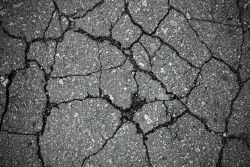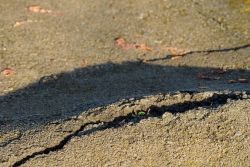


Look closely, does this look familiar?
No, they are not merely cosmetic imperfections. It's the writing on the wall, or in our case, the writing on the asphalt. As an owner of a parking lot, it's essential that you're able to recognize these imperfections. It's a matter of safety and budget, not just how your lot looks. Do you know what these cosmetic defects will become if they're left unattended? The fact that it doesn't look good will definitely be the last of your concerns. In time, tiny cracks grow into larger cracks, which become potholes turning your asphalt into a real deathtrap for both drivers and especially pedestrians. If you have only seen cracked asphalt on someone else’s lot, good for you. The question we hear often is when should we hire a repair and maintenance team? Unfortunately, not all types of asphalt damage are easy to see; however, this list can help you identify asphalt deformities before they deform your business and your budget.
Need an asphalt contractor in Baltimore? Contact Mid Atlantic Asphalt today!
CRACKS
Cracks are the most common symptoms of asphalt deterioration. The most common mistake that many property owners/ managers make is ignoring the first cracks that appear on the surface. Why are they dangerous? While cracks may be small, they leave asphalt vulnerable to the destructive effects of deicing salt, gas, oil, chemicals, and water, which will result in asphalt degradation. Asphalt cracking is particularly dangerous in the winter, when moisture seeps into cracks and then freezes. This process causes cracks to expand from inside and spread. A winter of neglecting just a couple of tiny cracks in asphalt could lead to a completely busted parking lot and a costly asphalt replacement by the spring.TYPES OF ASPHALT CRACKS
FATIGUE CRACKING
- What does it look like? The pattern of the cracks resembles the pattern of the crocodile scales. This is why it is also called crocodile cracking or alligator cracking, because of the crocodile-like pattern of the cracks.
- Why does it happen? Quite often alligator cracking is the result of distress caused by three damaging factors: thin base and sub grade, weaknesses in the surface and neglected drainage issues.
TRANSVERSE CRACKING
- What does it look like? It is a single crack that runs horizontally or perpendicularly to the centerline.
- Why does it happen? This type of cracking is mostly caused by the cracking of an underlying layer. The heat and construction errors also influence the damage.
- How to fix it? If the crack's width is less than 3/4 inch, it is sufficient to fill the crack in order to prevent the further destruction of the surface and subbase. However, if the crack is larger, the removal of the damaged area and an asphalt repair may be necessary.
JOINT REFLECTION CRACKING
- What does it look like? This damage is typical when asphalt was laid over top of concrete. The cracks reflect the places where a flexible layer is joined to the rigid base, resulting in a pattern of squares.
- Why does it happen? These cracks appear right over the flexible pavement overlay where it joins the rigid pavement.
 EDGE CRACKING
EDGE CRACKING
- What does it look like? As the name implies, these cracks can be seen on the edges of the surface.
- Why does it happen? Sometimes poor edge support is to blame. Sometimes such damage is caused by drainage conditions and heavy traffic load. Thickly growing vegetation near the pavement edge can also do this kind of harm by spreading and growing through the surface, which is not protected by the proper base.
- How to fix it? First of all, it is important to take care of vegetation and drainage issues. Next, edge cracks can either be fully removed and reconstructed or fixed with the help of crack sealing.
BLOCK CRACKING
- What does it look like? Cracks, which create shapes similar to rectangles.
- Why does it happen? The most common cause of this type of cracks are temperature cycles. If asphalt binder fails to expand and contract to changes in temperature, it results in block cracks. Dry mix and aged asphalt are other reasons for this damage.
SLIPPAGE CRACKING
- What does it look like? Crescent-shaped tears in the asphalt surface.
- Why does it happen? It is essential to use a tack coat or prime coat for bonding the asphalt to the base layer. When asphalt layers have poor bonding or no bonding at all, the emerging of slippage cracks is a matter of time. Another factor that contributes to this type of damage is the effect of such adhesion-preventing materials such as oil, dirt, and chemicals from penetrating to the sub base.
DEPRESSIONS
Also called birth baths, depressions are the areas of asphalt with a lower elevation compared to rest of the asphalt.
- Why are they dangerous? Depressions make a parking lot or a driveway uneven and harder to drive on. Also, if the depression gets filled with water after a rain, it is impossible for a driver or pedestrian to see how deep the depression truly is and whether it is safe to drive or walk. This could result in injury to pedestrians or damage to vehicles.
POTHOLES
The contraction and expansion of the ground underneath the layers of asphalt result in the weakening of pavement and forming of cracks. As they spread under the traffic load, pieces of asphalt get dislodged by vehicles. The hole that remains is called a pothole.
- Why are they dangerous? With their sharp edges and depth, potholes are particularly dangerous for moving vehicles. More importantly, bicyclists and pedestrians are often injured by potholes, creating a liability for your business.
RAVELING
Have you ever seen asphalt that looks like a bad case of the chickenpox? Then you have seen what raveling looks like. It is the erosion of asphalt that occurs when the asphalt is laid when the outside temperature is too cold. Due to insufficient warmth, the mixture does not get solidified properly, resulting in loss of structure, weakening and gradual deterioration.- Why are they dangerous? The weak asphalt layer is more prone to cracking, which results in severe foundation failures that endanger drivers and pedestrians.
WHAT TO DO NEXT?
Now we all know know more about asphalt damage and how they start. What's your next step if you find your asphalt damaged? It is difficult for many property owners to analyze their lot on by themselves. Some companies charge a costly fee for assessing a parking lot. Moreover, there is always a risk that you will be sold a total asphalt replacement, which is not budget friendly, when crack filling would have been the perfect and less expensive solution.HOW TO FIX IT?
If you're located in Maryland, Washington, D.C. or Delaware, then half of your job is already done. Mid Atlantic Asphalt has been servicing these areas for more than 45 years. A free asphalt analysis along with a free estimate to repair your damage asphalt is complimentary. At your request, our experts will arrive on site and assess the damage, the type of repairs and the final estimate. You will also be offered maintenance services to keep your repaired asphalt in top condition for many years to come. We prioritize precision and customer-oriented approach, so you are guaranteed a valid and honest evaluation. Contact us at (410) 999-1263.

